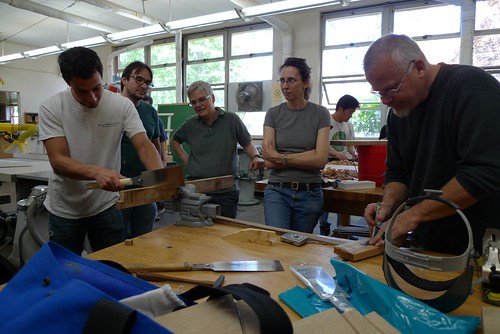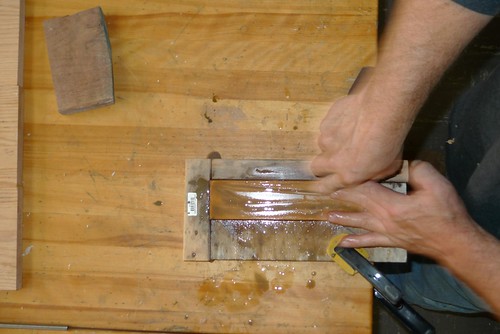The process is a little different with each iteration of the class. All the handouts I made last year were irrelevant by this time, as we have several new pieces of equipment.
Things we need prior to next Woodworking class:Jointer knives sharpened
Planer knives sharpened
Dedicated rip and crosscut blades for class
New marking gauges
New 3/8" Forstner bits
Make up a big batch of ebonizing solution
Write vocabulary quizzes
Other notes: recommend walnut or cherry over white oak
Make sure students read the PDF posted for the class, entitled "Gluing Up Tabletops".
Table Process• Joint and plane 8/4 wood for the legs and 4/4 for the aprons and top
• Rip the legs oversize and run through the planer to make them square
• Cut the legs to length with the sliding table and a crosscut blade
• Mark out the mortises (we need new marking gauges)
• Drill the mortises with a sharp Forstner bit,
• Grind and then hone a wide chisel and a narrow (skew the chisel on the Japanese water stone)
• Clean up/ square up the mortises
• Make the crosscuts for the tenon shoulders
• Use the mortising jig to cut the tenons
• Bandsaw the wide ends of the tenons with the rip fence, and fit them to the mortises
• Chisel away any remaining high points
• Glue up the tabletop (need: bucket of water, rags, glue, mallet, paper, pipe clamps.)
• Hand plane while table top is long
• Trim it to size on the sliding table with a sharp crosscut blade
• Taper the legs,
• Make biscuit slots to accommodate the table top mounting hardware,
• Sand all parts with 80 grit, 120, 180 and 220 grit sanding discs and hand sandpaper.
• Give most edges the “Bob Robinson Bevel”
• Glue up the table (need: bucket of water, rags, glue, mallet, paper, pipe clamps or Jorgensen bar clamps. Toothbrush would be helpful for glue removal.)
• Wipe table with damp rag to raise grain and show up glue spots
• Resand everything with 220 grit sandpaper (by hand)
• Apply first coat of finish (I recommend Minwax Wipe-On Poly, satin finish, or Watco Danish oil.) Use plenty of the Wipe-On Poly, and don't "go back in" with the rag after a minute or so, as it will start to get sticky and mess up what you have done.
• The next day, sand entire table VERY LIGHTLY with 220 or 320 sandpaper folded neatly over an MDF sanding block, (do not sand
through the first coat!!!) then apply a second coat of Wipe-On Poly.
• Apply the finish even to the undersides of the table legs-- they will take on and lose moisture faster than the rest of the table otherwise.• Install the table-top hardware using ½” #8 screws. Apply masking tape to drill bit to avoid drilling through table top, and screw in screws by hand.










































